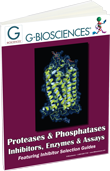 When you lyse cells, either through physical disruption or by adding detergents, you also release a variety of other proteins (proteases) that are potentially harmful to your target protein. These proteases can cleave the peptide bonds between the amino acids of polypeptide chains and leave you with multiple short peptide fragments. When this happens, you will end up getting erroneous results from your experiments (western blotting, reporter gene analysis, protein interaction or activity assays).
When you lyse cells, either through physical disruption or by adding detergents, you also release a variety of other proteins (proteases) that are potentially harmful to your target protein. These proteases can cleave the peptide bonds between the amino acids of polypeptide chains and leave you with multiple short peptide fragments. When this happens, you will end up getting erroneous results from your experiments (western blotting, reporter gene analysis, protein interaction or activity assays).
Thankfully, there are ways to foil the action of these proteases. You can either keep your samples cold or use protease inhibitors to prevent the degradation of your protein sample. Better yet, you can use a protease inhibitor cocktail to effectively inhibit protease action.
Protease Inhibitors
Basically, there are four main classes of proteolytic enzymes - serine proteases (trypsin, chymotrypsin and elastase), cysteine proteases (papain, calpain and lysosomal cathepsins), aspartic proteases (pepsin and rennin) and metallo-proteases (thermolysin and carboxypeptidase A). Any one or all of these enzymes may pose a threat to the fate of your target protein during isolation and characterization. This is specifically why you need to add a protease inhibitor to the mix.
Protease inhibitors are valuable chemical tools that are used to prevent the degradation of proteins in tissue or cell extracts caused by endogenous proteases. In addition, these reagents can also be used to investigate particular processes that involve blocking the activity of specific proteases. Some of the most common protease inhibitors include AEBSF, aprotinin, bestatin HCl, chymostatin, leupeptin, pepstatin A, PMSF, and chelating agents such as EDTA and EGTA.
Unfortunately, there is no single protease inhibitor that can inactivate every known protease so you may need to consider using a protease inhibitor cocktail to protect the integrity of your protein sample.
Protease Inhibitor Cocktails
Broad spectrum protease inhibitors and mixtures, also known as Cocktails, are optimized to inhibit the action of harmful proteases while maintaining and preserving the functionality of your protein. By utilizing a specific combination of protease inhibitors, you can effectively protect the integrity of your protein samples during extraction and purification.
While some researchers prefer to prepare the appropriate cocktail by themselves, some prefer using a pre-formulated cocktail made by a reputable company instead. Here are the main reasons why most researchers choose commercially available protease inhibitor cocktails:
- Cocktails are convenient and are extremely easy to use.
- They can be less expensive than purchasing individual inhibitors.
- Some cocktails are optimized by application. There are different cocktails for mammalian, plant or bacterial cell lysis. Some cocktails are enhanced with yeast and fungal specific protease inhibitors, while some are ideal for large scale preparative applications.
Tips in Choosing the Right Protease Inhibitor or Cocktail
- Ask for recommendations. Talk with vendors and take advantage of their knowledge about the strengths of different inhibitors for different conditions. To do this, you may need to provide the vendor with the details of your experiment (e.g. the particular sample types, assays, and applications you are using).
- Consider the mechanism of action. Since different types of inhibitors have different mechanisms of inhibition, you may need to determine what kind of protease you need to block before choosing an appropriate inhibitor.
- Start broad. When choosing which protease inhibitor or cocktail to use for your applications, it might be a good idea to start broad and then narrow down your focus. Try a pre-formulated cocktail first to see if it can satisfactorily address your proteolysis concerns. If it does not take care of the problem, you should then use a targeted approach for the specific tissue and protein of interest.
- Assay Protease Activity. Commercial protease assays are available that allow researcher's to identify the type of proteases present in their lysates. These assays, in conjunction with protease cocktails, will allow researchers to assess the effectiveness of their cocktail and supplement in additional inhibitors if required.
Image source: Didriks







